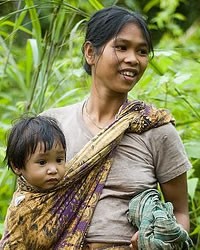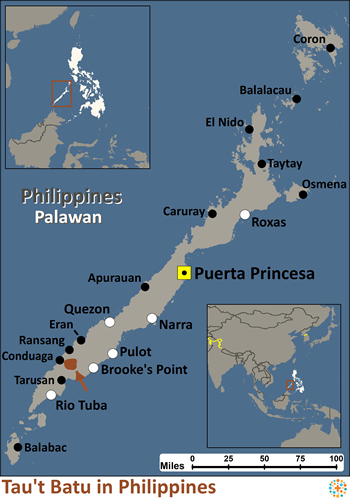The Tau't Batu people live in a very remote place which is not affected by any political activity. Because of their small numbers and simple ways, there are not many political activities among them.
The Tau't Batu are still practicing a simple lifestyle. The men are still wearing G-strings made of bark and cloth while the women are wearing a skirt made of a piece of cloth to cover their lower body. Most of them are half naked, but because of the outside influence through trade, women are beginning to wear a blouse.
They live around cave dwellings in which they construct a house framework made of light and sturdy materials such as saplings. They make sleeping platforms and multi-purpose platforms to serve as floors or beds.
The Tau't Batu practice marriage groups or "ka-asawahan", which serves as the basic social unit among them. The "Ka-asawahan" or household units can be basically made up of a couple, man and his wife, to several numbers of couples. They are further grouped into a larger association called "Bulun-bulun". The system is an arrangement of several couples co-habitating in a single cave for residence. It is characterized by a system of sharing different kinds of social and material exchanges such as food and other equipment.
The Tau't Batu are music-lovers. They know how to play two musical instruments known as "Kubing" and "Kudlong" in addition to the gong.
The Tau't Batu are cultivators who practice multiple cropping with cassava as the major product. They also plant sweet potato, sugarcane, garlic, pepper, string beans, squash, tomato, pineapple and other plants which will grow on their farms. They are also fond of hunting and foraging to supply their need for more carbohydrates. Wild pigs are the most hunted animals.
Trade among the Tau't Batu is done through "Sambi" (barter) or "Dagang" (monetary exchange). Tau't Batu's trade is specifically for marine fish which they get from the neighboring Candawaga people. The Tau't Batu people also trade forest products such as almaciga and rattan. They are also good in basketry.
The Tau't Batu people have their own religion which centers around spirits. They believe they must serve and appease these spirits to gain blessings and not be put under curses.
Although the population is very small, they need a spiritual leader and a church.
Perhaps because of their late exposure to modern civilization, there is a great need for literacy ministry among them. This could pave the way towards their spiritual salvation.
As the community becomes open to modernity, the people must be protected from the abrupt changes that they may experience in the future. There must be enough time to prepare them for modernization.
Pray for the authority of Christ to bind hindering spiritual forces and lead them to the Light of the World.
Pray for signs and wonders among the Tau't Batu people and for great breakthroughs with a rapid multiplication of disciples and house churches.
Pray for bold workers who are driven by the love of the Holy Spirit to go to them.
Scripture Prayers for the Tau't Batu in Philippines.
Asia Missions (AMNET)
| Profile Source: Joshua Project |

























